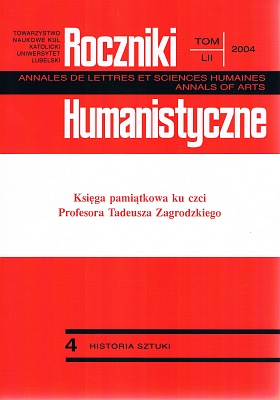The picture of the Czech art according to Wlastimil Hofman
Abstract
The text is a scholarly interpretation of the manuscript of Wlastimil Hofman's lecture on Czech art, delivered on 16 January 1934 in the Jagellonian University in Cracow. The manuscript comes from Jiài Karásek's collection that since 1960 has been kept in Prague, in the collection of Památník národního písmnictví. Seventy years ago in his lecture Wlastimil Hofman gave an outline of the history of Czech painting, starting from the period of the early Gothic, up to the artists and works from the break of the 19th century that were most important for Czech art. The choice of the Czech artists and their works presented to Polish students was influenced by both the Polish painter's personal views of social-historical nature and his artistic preferences – Hofman knew well Prague's artistic circles of those times and historical and political determinants, also of art, of the then young Czechoslovakia. In the text of his lecture Wlastimil Hofman did not conceal the fact that he did not know the old Czech art very well, so he fully based his opinions about artists and about their works, especially of the Gothic, Renaissance and baroque periods, on opinions expressed by the Czech historians of art who specialized in those periods, like Vincenc Kramaø or Vojtéch Volavka. Only the 19th century Czech painting that Hofman knew well was treated by the Polish painter more broadly and in greater detail. In this part of his lecture the artist expressed his personal tastes and likings, especially in reference to Czech artists of the period of the so-called “national awakening” that started at the break of the 18th century, when, first on the grounds of the Enlightenment ideology, and then of the 19th century nationalism the Czechs undertook actions aiming at revival of their nation. Along with building the foundations of a new economic structure and modern forms of political life they created the basic elements of the literary Czech language, of literature and of their own national art. Owing to the efforts they undertook, in all domains of life – starting from economy and ending with the problems connected with developing the nation's creative powers and national consciousness (with a special emphasis on the element of education, ethics and art), Czech entered the 20th century as the only nation in Central and Eastern Europe that did not have its own state, and after World War I, in 1918, they established Czechoslovakia, a country that was an element of Europe of that time within the so-called Versailles order, and one that was the crowning of the many centuries of Czechs' and Slovaks' national aspirations.
Copyright (c) 2004 Roczniki Humanistyczne

This work is licensed under a Creative Commons Attribution-NonCommercial-NoDerivatives 4.0 International License.





